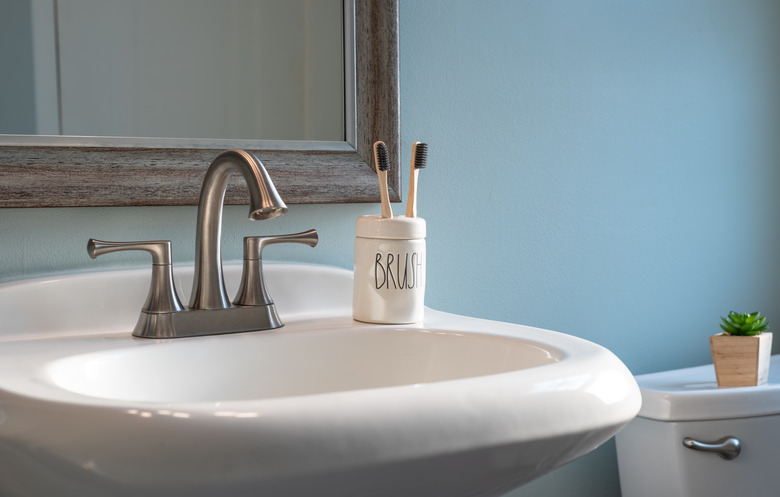How To Fix A Leak In The Bathroom Sink
When you open the cabinet under your bathroom sink and see water, chances are good that you have a leak. Part of knowing how to fix a leak in a bathroom sink is figuring out exactly where the leak is coming from. Once you know from where the leak originates, you can repair or replace the defective part.
Bathroom sink leaks are usually caused by a bad drainpipe, loose pipe connection, or leaky sink drain flange. Fill the sink with water and determine where your particular leak is located.
Clean the Sink Drain Flange
1. Turn Off the Water Supply
Shut off the water to the house.
2. Disconnect the Sink Trap From the Drain
Use a pair of tongue-and-groove pliers to loosen the slip nut that attaches the sink trap to the main drain line coming from the wall. Loosen the nut without disconnecting the sink trap. Disconnect the sink trap from the drain coming from the sink by loosening the slip nut connector. Pull down slightly on the sink trap to remove it from the sink pipe and swing the sink trap out of your way.
3. Release the Stopper Mechanism
Use tongue-and-groove pliers to remove the slip nut connecting the sink drainpipe to the sink drain. If your sink drain has a built-in stopper, this will not be necessary. You will need to disconnect the stopper mechanism from the pull stem. There is a thumbscrew that connects the two. Turn the thumb screw counterclockwise to release the stopper mechanism.
4. Clean Beneath the Flange
Use a pipe wrench to remove the retaining nut securing the sink drain to the sink. If necessary, tap the sink drain from the bottom to break the old plumber's putty seal. Lift the sink drain out and inspect it. Clean the sink hole using a plastic putty knife to remove plumber's putty. If the sink flange is bent or damaged, replace it. Most likely, you will only need to clean underneath the flange to remove old, cracked plumber's putty.
5. Apply Plumber's Putty
Roll a small ball of plumber's putty in the palm of your hands to form a thin rope. Set the rope of plumber's putty on the underside of the sink drain flange. Set the sink drain back into the sink and press it firmly in place. Attach the retaining nut to the sink drain from underneath the sink.
6. Add Plumber's Tape and Reassemble
Wrap plumber's tape around any pipe threads. Reconnect all of the pipes in the order they were removed. Tighten down all of the slip nuts using tongue-and-groove pliers.
Replace the Sink Drainpipes
1. Turn Off the Water Supply
Shut off water to the house.
2. Remove the Drain Assembly
Use tongue-and-groove pliers to remove the slip nut connecting the sink trap to the wall drainpipe. Disconnect the drainpipe from the sink drain directly underneath the sink. Remove the drain assembly from the sink cabinet. You will have the sink trap and tail piece in one piece.
3. Purchase a New Drain Assembly
Take the old assembly with you to the hardware store. Match the new sink trap and tail piece to make sure you have the correct diameter for your system. Make sure to pick up three new slip nuts as well.
4. Add Plumber's Tape
Wrap plumber's tape around all exposed pipe threads.
5. Connect and Tighten the Tail Piece
Slide a slip nut over the unthreaded end of the new tail piece with the threaded part of the nut pointed out. Connect the tail piece to the sink drain and tighten the slip nut with the tongue-and-groove pliers.
6. Secure the Sink Trap
Slide the remaining two slip nuts on each end of the new sink trap. Connect the sink trap to the main drain line coming from the wall using the slip nut to secure the sink trap. Attach the other end of the sink trap to the tail piece. Secure the sink trap to the tail piece by tightening down the slip nut.
Tighten Loose Connections
1. Tighten the Sink Drain Flange
Tighten down the sink drain flange using a pipe wrench to turn the retaining nut under the sink 1/4 turn.
2. Tighten Pipe Connections
Tighten all of the connections between pipes under the sink using tongue-and-groove pliers.
3. Disconnect and Clean Leaky Sections
Disconnect sections that will not stop leaking when tightened. Clean old plumber's tape off threads and apply new plumber's tape. Reconnect drain lines using tongue-and-groove pliers.
